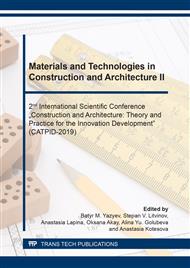[1]
V. Promakhov, A. Zhukov, I. Dubkova, I. Zhukov, S. Kovalchuk, T. Zhukova, A. Olisov, V. Klimenko, N. Savkina, Structure and Properties of ZrO2-20%Al2O3 Ceramic Composites Obtained Using Additive Technologies, Materials. 11 (12) (2018) 2361.
DOI: 10.3390/ma11122361
Google Scholar
[2]
A. Bazhanov, D. Yudin, V. Porkhalo, Development of modular control software for the 3D-printer construction, IOP Conference Series: Materials Science and Engineering. 327 (2) (2018) 022011.
DOI: 10.1088/1757-899x/327/2/022011
Google Scholar
[3]
A. Bazhanov, D. Yudin, V. Porkhalo, E. Karikov, Control system of robotic complex for constructions and buildings printing, IDT 2016 - Proceedings of the International Conference on Information and Digital Technologies. 7557145 (2016) 23–31.
DOI: 10.1109/dt.2016.7557145
Google Scholar
[4]
M.Y. Elistratkin, V.S. Lesovik, N.I. Alfimova, I.M. Shurakov On the question of mix composition selection for the 3D printing construction. Materials Science Forum. 945 (2019) 218-225.
DOI: 10.4028/www.scientific.net/msf.945.218
Google Scholar
[5]
M.Yu. Elistratkin, V.S. Lesovik, N.I. Alfimova, E.S. Glagolev, On developing of the building press technologies, Bulletin of Belgorod State Technological University named after. V. G. Shukhov. 5 (2018) 11–19.
DOI: 10.12737/article_5af5a727274397.04099320
Google Scholar
[6]
V.S. Lesovik, L.A. Suleymanova, A.G. Suleymanov, K.A. Kara, Non-autoclaved gas concrete on composite binders for energy-efficient construction, Bulletin of Belgorod State Technological University named after. V. G. Shukhov. 4 (2010) 47–52.
DOI: 10.12737/22024
Google Scholar
[7]
N.I. Alfimova, S.Yu. Pirieva, D.V. Gudov, I.M. Shurakov, Е.Е. Korbut, Optimization of prescribed-technological parameters of manufacture of cellular concrete mixture, Сonstruction materials and products. 1 (2) (2018) 30–36.
DOI: 10.34031/2618-7183-2018-1-2-30-36
Google Scholar
[8]
M.Yu. Elistratkin, M.I. Kozhukhova, Analysis of the strength increasing factors the of the non-autoclave gas concrete, Construction materials and products. 1 (1) (2018) 59–68.
DOI: 10.34031/2618-7183-2018-1-1-59-68
Google Scholar
[9]
L.A. Suleymanova, V.S. Lesovik, A.N. Kharkhardin, Topological properties of polydispersity composite binding for the non-autoclaved gas concrete, Bulletin of Belgorod State Technological University named after. V. G. Shukhov. 2 (2013) 46-50.
DOI: 10.33979/2073-7416-2020-88-2-35-43
Google Scholar
[10]
D.V.Q. Nguyen, Yu.M. Bazhenov, O.V. Aleksandrova, Effect of quartz powder and mineral admixtures on the properties of high-performance concrete, Scientific and Engineering Journal for Construction and Architecture. .14 (1) (124) (2019) 102-117.
DOI: 10.22227/1997-0935.2019.1.102-117
Google Scholar
[11]
V.S. Lesovik V.S., L.Kh. Zagorodnyuk, A.A. Kuprina, M.Yu. Elistratkin, A.N. Volodchenko, Effective masonry mortars for autoclave wall materials, Building materials. 12 (2016) 22-25.
Google Scholar
[12]
S.A.Yu. Murtazaev, M.Sh. Mintsaev, A.Kh. Alaskhanov, M.S. Saidumov, M.Z. Duskayev, Recycled technogenic raw materials as an effective filler for modern construction composites, Advances in engineering research international symposium on engineering and earth sciences. (2018) 271-274.
DOI: 10.2991/isees-18.2018.52
Google Scholar
[13]
Sh.M. Rakhimbayev, N.M. Tolypina, E.N. Khakhaleva, Influence of reactive fillers on concrete corrosion resistance, IOP Conference Series: Materials Science and Engineering 11. International Conference on Mechanical Engineering, Automation and Control Systems 2017 - Material Science in Mechanical Engineering,. (2018) 032046.
DOI: 10.1088/1757-899x/327/3/032046
Google Scholar


